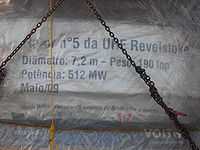Revelstoke Dam
| Revelstoke Dam | |
|---|---|
 | |
_location_map.svg.png) | |
| Location | Revelstoke, Canada |
| Coordinates | 51°02′58″N 118°11′38″W / 51.04944°N 118.19389°WCoordinates: 51°02′58″N 118°11′38″W / 51.04944°N 118.19389°W |
| Opening date | 1984 |
| Dam and spillways | |
| Impounds | Columbia River |
| Height | 175 m (574 ft) |
| Reservoir | |
| Creates | Lake Revelstoke |
| Surface area | 11,534 ha (28,501 acres) or 115 km2 (44 sq mi) |
| Power station | |
| Operator(s) | BC Hydro |
| Turbines | 5 |
| Installed capacity | 2,480 MW |
The Revelstoke Dam, also known as Revelstoke Canyon Dam, is a hydroelectric dam spanning the Columbia River, 5 km (3.1 mi) north of Revelstoke, British Columbia, Canada. The powerhouse was completed in 1984 and has an installed capacity of 2480 MW.[1] Four generating units were installed initially, with one additional unit (#5) having come online in 2011. The reservoir behind the dam is named Lake Revelstoke.[2] The dam is operated by BC Hydro.
Areas inundated
Areas inundated by the dam include the Dalles des Morts or "Death Rapids", which was the stretch of canyon just above the dam's location, and various small localities along the pre-inundation route of the Big Bend Highway, which was the original route of the Trans-Canada Highway until the building of its Rogers Pass section. Just below the dam was the location of La Porte, one of the boomtowns of the Big Bend Gold Rush and the head of river navigation via the Arrow Lakes and Columbia River from Marcus, Washington.
Revelstoke Dam Visitor Centre
The Revelstoke Dam Visitor Centre is located 5 km (3.1 mi) north of Revelstoke and is open seasonally. The centre features interactive exhibits, activities about the dam and hydroelectricity and a First Nations gallery opened in 2009, with exhibits about the art, history and culture of the Secwepemc (Shuswap), Okanagan and Ktunaxa peoples. There is also a theatre, gift shop, and outdoor walkway across the top of the Powerhouse.
Expansion
BC Hydro recently added a fifth generating unit. The unit went online in 2011 and added 500 MW capacity, bringing the total generating capacity of the dam to around 2480 MW.[3][4]

See also
- Mica Dam
- Keenleyside Dam
- Hydroelectric dams on the Columbia River
References
External links
| Wikimedia Commons has media related to Revelstoke Dam. |
- BC Hydro Revelstoke Dam Visitor Centre page
- BC Hydro regional power generation info
- BC Hydro information on fifth generating unit
| |||||